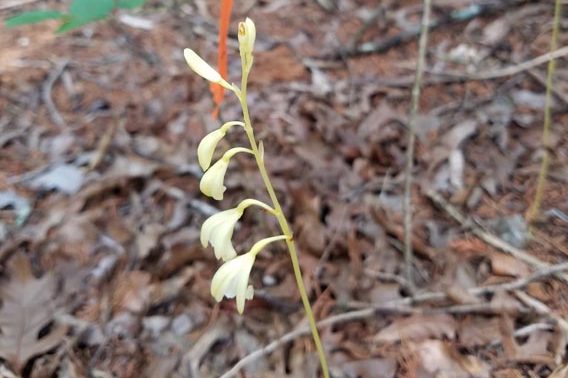
Orchid conservation draws volunteers in Texas
The envelope, please……and the winner is………Hexalectris warnockii!
All over the world we find people who are willing to volunteer their time to brave the elements and get their hands dirty in working to preserve and protect habitats of native species. My fellow orchid enthusiasts will be happy to learn that North Texas Master Naturalists have been actively engaged in orchid conservation efforts for years. This year I once again took part in the annual native orchid survey for our area, and it was a richly rewarding experience.
Survey of North Texas Orchids – July 2017
Even on my first survey day on June 20th this year I could tell that it was going to be a good year for the Hexalectris warnockii. On that day alone, we tagged over 120 specimens without breaking a sweat. The part about the 120 specimens is true; the part about not breaking a sweat – not so much. his is Texas, after all, and it did get a bit hot later that morning, but that is the burden of orchid hunters throughout history. Don’t try to tell me that those hunters of the past had groomed trails with mileage markers along the way, knowledgeable guides, and friendly indigenous people. On our outing, though, we are happy to report the indigenous urbanite tribes we encountered on the forest trails were all friendly. They mostly just ignored us as they jogged past with wires hanging from their ears.
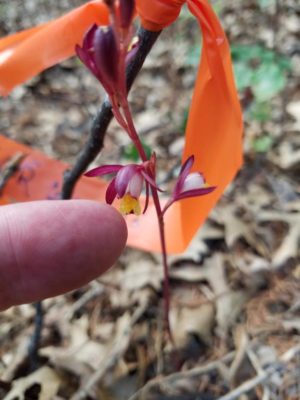
Hexalectris warnockii – Texas Master Naturalists Survey
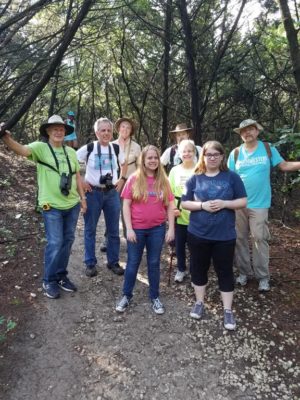
Greater North Texas Master Naturalists – Survey Team July 6, 2017
Stephanie Varnum, who has 14 years’ experience doing this survey with her late husband Jim. Stephanie safely led this year’s team, wrapping up the final tagging phase of the season on July 7. The final count, was 323 H. warnockii out of a grand total of 447 orchids. This year’s H. warnockii count, according to her analysis, is above average. The balance included 91 H. nitida (low), 30 H. spicata (high), and 3 H. arizonicas (low). The last phase of the survey will be on July 21 when, we will break into teams and collect each of the ribbon tags and measure the height of each find.This information will be sent to Dr. Marcy Brown-Marston, who has contributed to several published reports on Texas orchids.
Greater North Texas Orchid Society members join in the survey
The success of this venture was surely enhanced by the efforts of brave new explorers from the Greater North Texas Orchid Society (GNTOS), Karl and Carol Varian, who joined us on the last two days of the survey. Carol’s notable contribution was that she spotted a somewhat rare yellow version (forma lutea) of the H. warnockii, glowing in the sunlight about 3 meters from the trail. Talk about good eyes! Not to be outdone, Karl spotted one of the few H. arizonicas found in the survey. I later learned that H. arizonicas are quickly identified as the only one of the four native species that grow up to 80 centimeters in height.
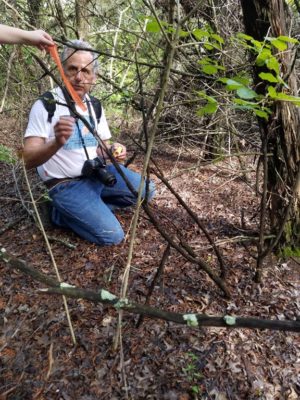
Karl tagging his find – Cedar Ridge Preserve, North Texas
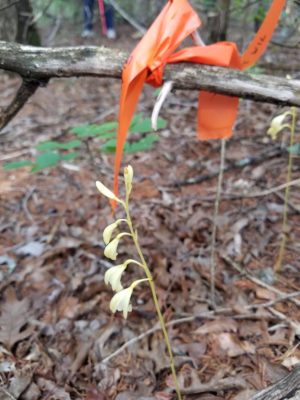
Yellow Hexalectris warnockii, Cedar Ridge Preserve 2017
We are lucky to have an array of terrestrial orchids, especially the H. warnockii, in Dallas county. The H. warnockii is named after Barton Warnock1, who explored the western part of Texas in the Trans Pecos botanical ecoregion. If you read the history behind the 1960 selection for the official flower of the Southwestern Orchid Growers Association (SWROGA) you would think that the H. warnockii is found only in that western part of the state. At that time, it probably was. But fast forward to 2008, and the Field Guide to the Wild Orchids of Texas by Paul Martin Brown shows ten counties in Texas having H. warnockii. Jim Varnum’s guide sheet used for this survey show botanical drawing of the H. warnockii from the Illustrated Flora of North Texas, (George M. Diggs, Jr., Barney L. Lipscomb, Robert J. O’Kennon) BRIT (Botanical Research Institute of Texas), dated 1999.
It would be interesting to locate the BRIT’s herbarium samples dating back to the 1937 specimen collected by Warnock himself to see when later locations were added to the Texas map.
Trivia: The author above (Paul Martin Brown) credits the discovery of H. grandiflora in Dallas to the work of this survey team started by Dr. Marcy Brown-Marston and organized by Jim and Stephanie Varnum.
We all owe gratitude that the Dallas chapter of the Texas Master Naturalists continue to conduct this survey year after year, and that their efforts contribute to the knowledge of native orchids of North Texas.
* * *
Barton Holland Warnock – the man who led the way
1According to Wikipedia, Barton Holland Warnock (1911–1998) was an American botanist and leading authority on flora of the Trans-Pecos area and northern Chihuahua Desert.
“Born in Christoval, Texas in July 1911, Warnock grew up at Fort Stockton, Texas and by 1937 graduated from Sul Ross State University (then Sul Ross State College) in Alpine, Texas. He received a master’s degree from the University of Iowa and a Ph.D. from the University of Texas in Austin.
In 1946 Warnock joined the faculty of Sul Ross State College and a year later was named biology department chair. He worked there for more than 50 years until retirement, during which he continued collecting various plant species in the region. He wrote three books from 1970 to 1977 and was working on a fourth volume.
Warnock died from a heart attack at the age of 86 on June 16, 1998 while driving a car near Alpine. After his death, the Sul Ross science building was named after him. The Barton Warnock Environmental Education Visitor Center, a state park near Lajitas in Presidio County, Texas, also bears his name and houses his extensive collection of plant specimens. An endemic genus of plants Lamiaceae (Warnockia) is named in his honor as well.”![]()